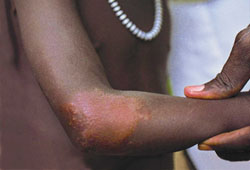Summary
Definition
History and exam
Risk factors
- close contact with a person with multibacillary leprosy
- poverty
- residence in endemic area
- genetic predisposition
- zoonotic transmission
Diagnostic tests
Treatment algorithm
Contributors
Authors
Maria T. Ochoa, MD
Clinical Professor of Dermatology
USC Keck School of Medicine
Department of Dermatology
Los Angeles
CA
Disclosures
MTO declares that she has no competing interests.
Acknowledgements
Dr Maria T. Ochoa would like to gratefully acknowledge Dr Denis Paul Jacques Daumerie, a previous contributor to this topic. DPJD declares that he has no competing interests.
Peer reviewers
Hubert Sansarricq, MD
Member of World Health Organization Panel of Experts on Leprosy
Saint-Armour Morlaas
France
Disclosures
HS declares that he has no competing interests.
David M. Scollard, MD, PhD
Chief
Clinical Branch
National Hansen's Disease Programs
Baton Rouge
LA
Disclosures
DMS declares that he has no competing interests.
Alexandre Tiendrebéogo, MD, MPH
Medical Officer
Leprosy and Neglected Tropical Diseases in Central Africa Countries
World Health Organization
Country Office of Kinshasa
DR of Congo
Disclosures
AT declares that he has no competing interests.
Use of this content is subject to our disclaimer
